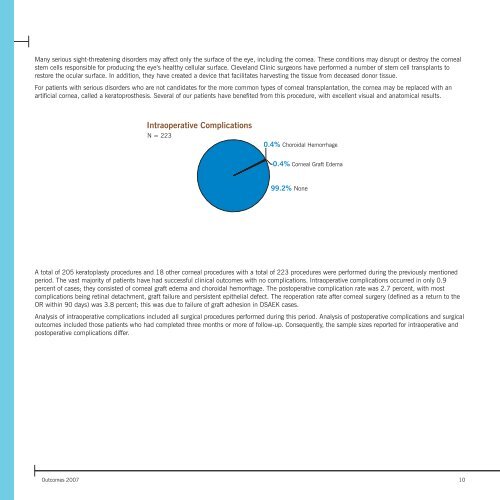Cole Eye Institute - Cleveland Clinic
Cole Eye Institute - Cleveland Clinic
Cole Eye Institute - Cleveland Clinic
You also want an ePaper? Increase the reach of your titles
YUMPU automatically turns print PDFs into web optimized ePapers that Google loves.
4000<br />
2000<br />
0<br />
Many serious sight-threatening disorders may affect only the surface of the eye, including the cornea. These conditions may disrupt or destroy the corneal<br />
stem cells responsible for producing the eye’s healthy cellular surface. <strong>Cleveland</strong> <strong>Clinic</strong> surgeons have performed a number of stem cell transplants to<br />
restore the ocular surface. In addition, they have created a device that facilitates harvesting the tissue from deceased donor tissue.<br />
For patients with serious disorders who are not candidates for the more common types of corneal transplantation, the cornea may be replaced with an<br />
artificial cornea, called a keratoprosthesis. Several of our patients<br />
Intraoperative<br />
have benefited<br />
Complications<br />
from this procedure, with excellent visual and anatomical results.<br />
Intraoperative Complications<br />
N = 223<br />
0.4% Choroidal Hemorrhage<br />
0.4% Corneal Graft Edema<br />
99.2% None<br />
A total of 205 keratoplasty procedures and 18 other corneal procedures with a total of 223 procedures were performed during the previously mentioned<br />
period. The vast majority of patients have had successful clinical outcomes with no complications. Intraoperative complications occurred in only 0.9<br />
percent of cases; they consisted of corneal graft edema and choroidal hemorrhage. The postoperative complication rate was 2.7 percent, with most<br />
complications being retinal detachment, graft failure and persistent epithelial defect. The reoperation rate after corneal surgery (defined as a return to the<br />
OR within 90 days) was 3.8 percent; this was due to failure of graft adhesion in DSAEK cases.<br />
Analysis of intraoperative complications included all surgical procedures performed during this period. Analysis of postoperative complications and surgical<br />
outcomes included those patients who had completed three months or more of follow-up. Consequently, the sample sizes reported for intraoperative and<br />
postoperative complications differ.<br />
Outcomes 2007 10
















